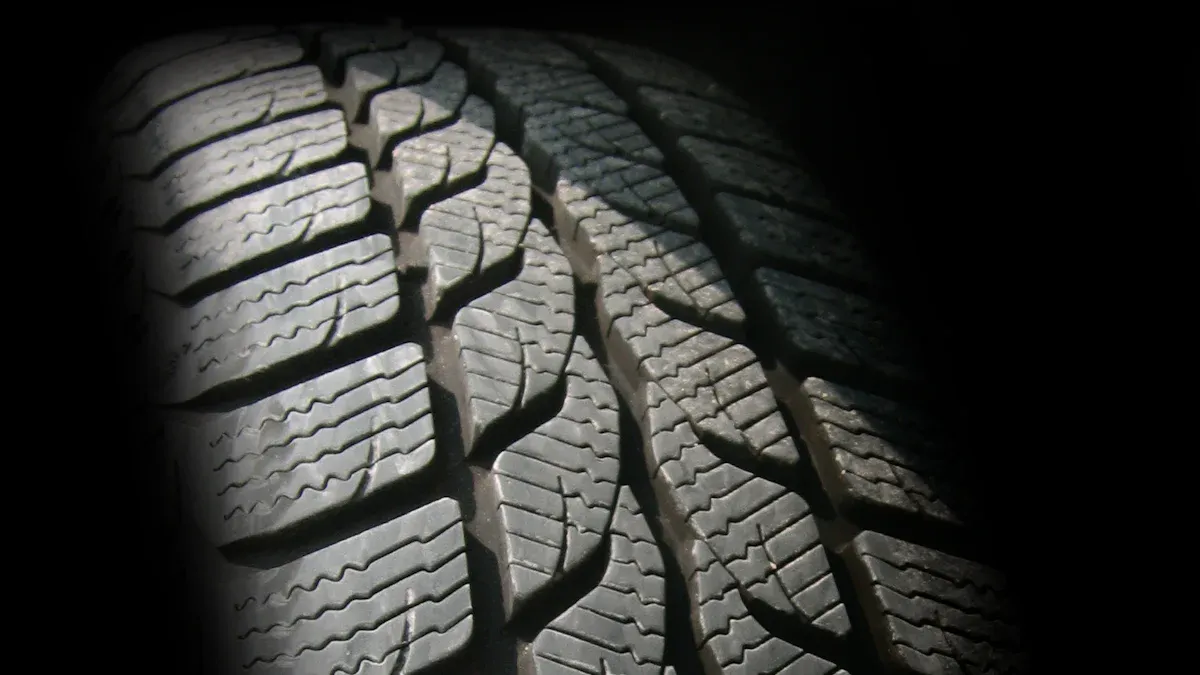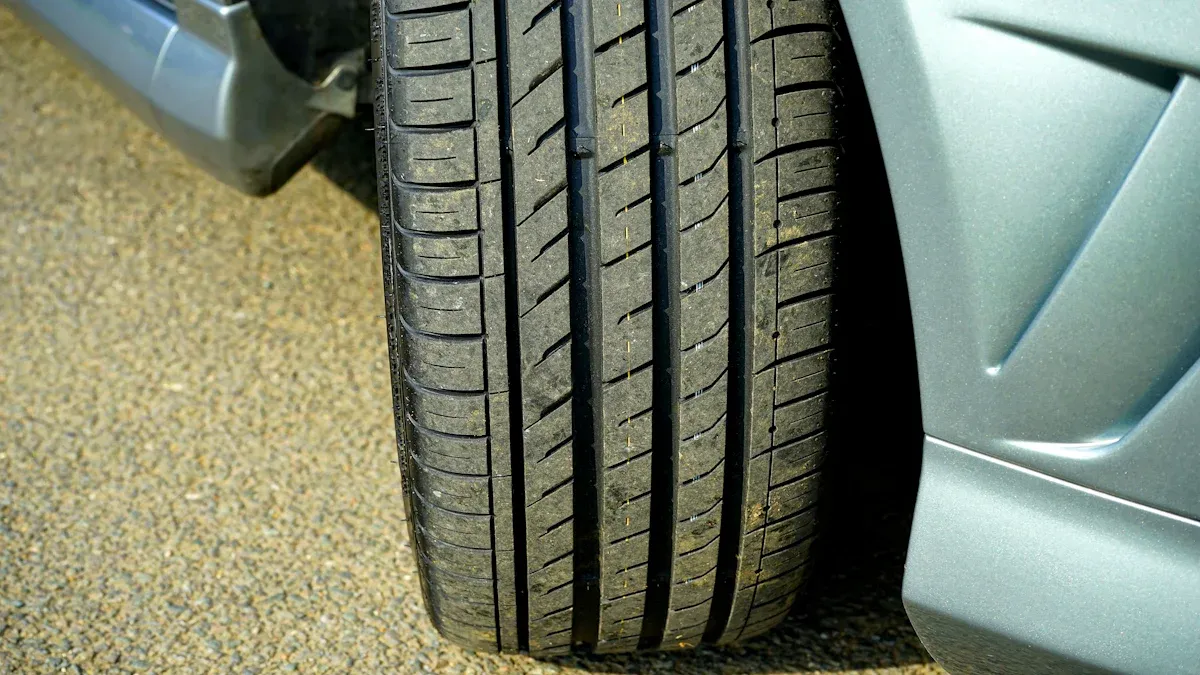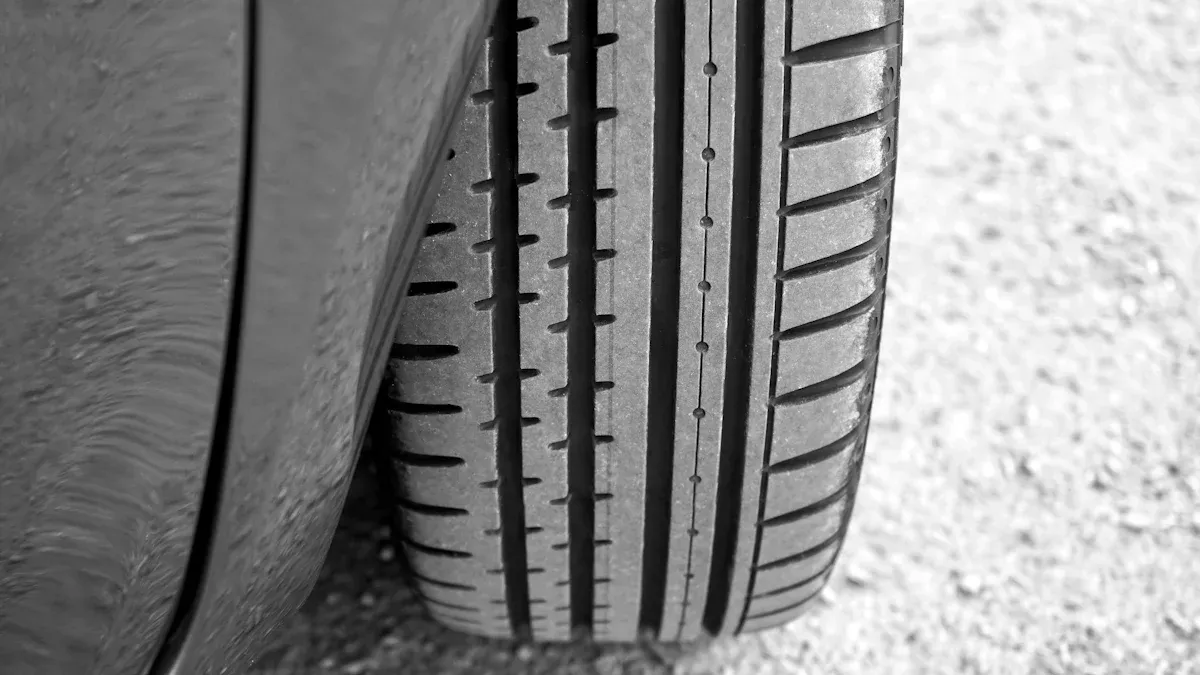
Measuring tread depth is very important for safety in high-risk cargo fleets. Good tread depth helps keep traction and shortens braking distances. Ignoring tire checks can cause serious problems. For instance, around 35% of crashes with vehicles are due to tire issues. Regular checks help find problems before they get worse, making safety better. Also, the Federal Motor Carrier Safety Administration (FMCSA) requires pre-trip inspections. Not following these rules can lead to fines and problems with operations. Focusing on tread depth during these checks is key for safe operations in high-risk cargo fleets.
Pontos-chave
Check tire tread depth often to keep safe and follow rules.
Keep a minimum tread depth of 4/32 inches for front tires and 2/32 inches for other tires to avoid accidents.
Use both manual and digital tools to measure tread depth correctly for better safety and performance.
Do regular tire checks and train drivers to find problems early and make fleet safety better.
Taking care of tires helps with better fuel use, longer tire life, and less chance of blowouts.
Tread Depth Regulations
Knowing the rules about tread depth is very important for keeping your fleet safe. Both federal and state laws set minimum tread depths that you must follow to keep things safe.
Federal Standards
The Federal Motor Carrier Safety Administration (FMCSA) makes clear rules for tire tread depth. Here are the minimum needs:
Steer Tires: You need a minimum tread depth of 4/32 de polegada for the front wheels of buses, heavy-duty trucks, and truck tractors.
All Other Tires: For drive tires and trailer tires, the minimum tread depth is 2/32 de polegada.
These rules are not just suggestions; they are laws. Not following them can cause serious problems. Police can give tickets, and your vehicle may be taken off the road until you change the tires.
Date | Descrição |
|---|---|
7/14/2022 | Regulatory amendment update |
7/08/2022 | Regulatory amendment update |
6/08/2022 | Regulatory amendment update |
State Guidelines
State rules can be different from federal standards. You should know your state’s specific rules, as they may have stricter ones. Here are some important points to think about:
Some states have extra rules about winter tire chains.
You might see different tread depth needs for mountain driving.
Retreading limits and weight rules for tire loading can also change by state.
Always check your local rules to make sure you follow them. Ignoring these rules can raise accident risks, which can hurt your fleet’s safety and insurance.
Many myths exist about tire tread depth rules. For example, some people think that having a shallow tread depth saves fuel costs. But this can create dangerous situations. The FMCSA sets minimum tread depths at 4/32 polegadas for the front axle and 2/32 polegadas for other spots.
Safety Implications for High-Risk Cargo Fleets
Impact on Vehicle Performance
Keeping the right profundidade do piso is very important for how well your cargo fleet vehicles work. When you have enough tread depth, you get better traction, faster braking, and improved handling. Here are some important points to think about:
Braking Distance: When tire tread gets worn down, your vehicle stops slower, especially on wet roads. At the legal minimum tread depth, your braking power in wet conditions drops to only 64% of what it was when the tires were new. This means you need more distance to stop, which can be risky in emergencies.
Risco de Aquaplanagem: Low tread depth raises the chance of hydroplaning. If your tires can’t push water away well, your vehicle might lose grip on the road. This makes stopping harder and can lead to losing control, putting your cargo and drivers in danger.
Eficiência de Combustível: Keeping the right tread depth also helps with fuel efficiency. The tread design and materials make up 35-50% of a tire’s rolling resistance, which affects how much fuel you use. Tires with less tread create less heat, which helps save fuel since less energy is wasted.
Risk of Accidents
Ignoring tread depth can cause serious safety problems, like tire blowouts and accidents. Here’s how not having enough tread depth can raise these risks:
Tire Blowouts: Tires with low tread depth are more likely to blow out. A blowout can lead to losing control quickly, causing accidents with other vehicles or objects. This risk is higher for high-risk cargo fleets, where heavy loads can make things worse.
Tread Separation: Low tread depth can also cause tread separation. This happens when the tread layer comes off the tire, making it unstable and increasing the chance of an accident. Regular checks are important to spot any wear before it leads to big problems.
Seasonal Weather Conditions: Not having enough tread depth raises safety risks, especially in wet or icy weather. For example, the minimum tread depth for front tires (steer tires) is 4/32 of an inch. Going below this level can hurt your vehicle’s ability to drive safely in bad weather.
By focusing on tread depth during your pre-trip inspections, you can lower the chance of accidents and improve fleet safety. Regularly checking and maintaining tire tread depth is crucial for keeping your high-risk cargo fleets safe and efficient.
Measuring Tire Tread Depth

Measuring tire tread depth correctly is very important for keeping your cargo fleet safe. You can use manual methods or digital tools. Each has its own benefits.
Manual Measurement Techniques
There are several easy manual ways to measure tire tread depth. Here are some common methods:
Technique | Descrição |
|---|---|
Canadian Quarter | Put a quarter into the tread; if the tread covers the caribou’s nose, it shows you have enough tread depth. |
Use a gauge to find the shallowest groove; this gives you an exact measurement of tread depth. | |
Tread Wear Indicators | Look at built-in indicators or wear bars; if they are worn down, it means the tires need to be replaced right away. |
These methods are simple and help you check your tires quickly. But, they might not always give the most accurate results.
Digital Measurement Tools
Digital tools for measuring tire tread depth are more accurate. For example, mobile scanners can measure down to 0.3 mm. They check a larger area of the tire, giving better data than manual methods, which usually check just one spot.
Some top digital tools include:
ContiTrack2: This system does digital tire checks and gives detailed reports on tire wear and tread depth. It helps improve performance and find ways to save money.
TreadReader HandHeld Scanner: This small device gives detailed analysis of tread depth and tire wear, reducing mistakes from manual gauges.
Dana’s Rhombus TireAnalytics: This cloud-based system keeps track of tire health across fleets, improving visibility and management for maintenance teams.
By using these tools for your tire tread depth checks, you can make sure you follow the rules and keep your fleet safe.
Regular Tire Inspections and Maintenance

Taking care of your tires is very important for keeping your cargo fleet safe and running well. Regular tire checks and maintenance can help your tires last longer and make your fleet safer. Here are some good practices to follow:
Best Practices for Inspections
Choose the Right Tire: Pick tires that fit your vehicle’s needs and weight. Talk to local tire dealers to help you choose the best ones.
Maintain Inflagem Adequada: Check tire pressure every week. If tires are not inflated enough, it can waste fuel and wear them out faster. Keeping tires at the right pressure helps save fuel and makes driving easier.
Implement Routine Checks: Do daily visual checks. Look for signs of wear, damage, or low tread depth. Regularly check tire alignment and rotation to stop uneven wear.
Rotate Tires Regularly: Rotating tires often helps wear them evenly. This is important for making tires last longer and keeping good traction, especially when carrying heavy loads.
Monitor Tread Depth: Use a tread depth gauge to measure accurately. Tires with a tread depth of 6/32″ can stop much faster than those with 2/32″, showing why regular checks are important.
Dica: Keeping a maintenance log can help you track inspections and follow safety rules.
Driver Training
Teaching your drivers about tire safety and inspection skills is very important. Drivers who know what to look for can spot tire problems before they get worse. Think about using these training programs:
Program Name | Descrição |
|---|---|
Driver Safety Training Courses Online | Teaches important skills for driving commercial vehicles safely, including how to inspect vehicles. |
Commercial Driving Fundamentals Online | Offers interactive lessons on key requirements and best practices, including trip inspections. |
Transportation & Driver Safety Training | Provides training on DOT rules and helps drivers prepare for roadside inspections. |
Regular tire inspections, including checking tread depth, are key for safety and following rules. Finding uneven tire wear during checks can lead to fixes that save money and improve safety. By investing in driver training, you help your team keep tires healthy, which lowers accident risks and boosts fleet safety.
Measuring tread depth during your pre-trip inspections is very important for safety and following the rules. Regular checks help you find problems before they get worse. Taking care of tires not only makes things safer but also helps your fleet run better.
Think about these benefits of good tire management:
Benefício | Descrição |
|---|---|
Keeping tire data in one place makes things simpler and saves time. | |
Following set routines and checking regularly leads to healthier tires and better performance. | |
Longer Tire Life | Taking care of tires well reduces downtime and improves how your fleet works overall. |
By focusing on tread depth, you make sure your fleet runs safely and efficiently.
Perguntas Frequentes
What is the minimum tread depth required for cargo fleet tires?
The minimum tread depth for steer tires is 4/32 de polegada. For drive and trailer tires, it is 2/32 de polegada. Always check both federal and state rules for specific needs.
Com que frequência devo verificar a profundidade da banda de rodagem dos pneus?
You should check tire tread depth at every pre-trip inspection. Regular checks help you find wear and avoid safety problems before they get worse.
Que ferramentas posso usar para medir a profundidade da banda de rodagem?
You can use manual methods like a medidor de profundidade do sulco do pneu or a Canadian quarter. Digital tools like the TreadReader HandHeld Scanner give more accuracy and detailed information.
Why is proper tread depth important for safety?
Proper tread depth gives better traction, shorter stopping distances, and lowers the chance of hydroplaning. It greatly improves vehicle control, especially in bad weather.
What are the consequences of ignoring tread depth checks?
Ignoring tread depth checks can cause tire blowouts, accidents, and legal issues. It puts safety at risk and can lead to expensive repairs and higher insurance costs.
Veja Também
A Importância de Monitorizar a Profundidade do Piso dos Pneus para Segurança
Utilização de um Medidor de Profundidade do Piso dos Pneus para Medições Precisas
Compreender Detectores Inteligentes de Profundidade do Piso dos Pneus e a sua Funcionalidade






